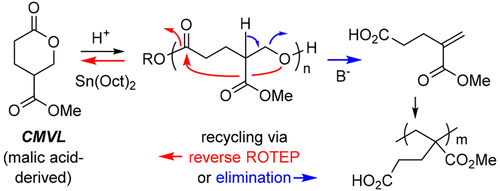Fahnhorst, G. W.; Hoye, T. R. ACS Macro Lett. 2018, 7, 143–147.
We report here the synthesis of a novel substituted polyvalerolactone from the renewable monomer, 4-carbomethoxyvalerolactone (CMVL, two steps from malic acid). The polymerization proceeds to high equilibrium monomer conversion to give the semicrystalline carbomethoxylated polyester with low dispersity. The material displays a glass transition temperature of −18 °C and two melting temperatures at 68 and 86 °C. This polymer can be chemically recycled by either of two independent pathways. The first (red) cleanly returns CMVL by a backbiting depolymerization from the hydroxy terminus; the second (blue) uses a base to cleave the polyester in a retro-oxa-Michael fashion. This affords a methacrylate-like monomer that we have polymerized radically to a new polymethacrylate analogue. This is a rare example of a polymer that has been shown to have two independent chemical recycling pathways leading to two different classes of monomers.
